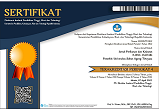Bioeconomic analysis of squid fisheries in the Karangantu fishing port of Banten Province
Abstract
Squid is one of the catches of fisheries favored by the community and one of the fisheries commodities with high economic value. In 2017 the squid production in the Karangantu archipelago fisheries port reached 328 tons or 14.3% of the total capture fisheries production, which reached 2,293 tons. All Squid that enters the market come entirely from catches in nature (sea); if you only rely on the effort of catching it alone, one day, there may be overfishing. This study aimed to determine the optimal level of Squid (Loligo sp.) Resource management is based on biological and economic aspects in the Karangantu PPN. The study was conducted from April to May 2019. Retrieval of primary data and secondary data funds. The research procedure consisted of calculating CPUE (Catch Per Unit Effort), MSY (Maximum Sustainable Yield), and MEY (Maximum Economic Yield) using primary data and secondary data obtained from Karangantu. The calculation of bioeconomic analysis using the Gordon-Schaefer model showed that the highest profit value was in the MEY condition of 234,423 kg/year and 2,622 trips/year with a gain of Rp. 2,901,811,197. Based on the Fox model, the utilization rate of Squid (Loligo sp.) It is 129% and is in the status of over exploited.
Keywords
Full Text:
PDFReferences
Hasan I. 2005. Pokok-Pokok Materi Statistik 2 (Statistik Inferensif) Edisi Kedua. Jakarta: Bumi Aksara.
Nazir M. 2014. Metode Penelitian. Bogor: Ghalia Indonesia. 486 hlm.
Khalifa MA. 20014. Kondisi Habitat dan Kehidupan Pesut (Orcaella brevirostris) di Teluk Banten [Tesis]. Bogor: Sekolah Pascasarjana, Institusi Pertanian Bogor. 66 hlm.
King M. 1995. Fisheries Biologi, Assessment: a Manual of basic methods 1. USA: John Wiley and Sons, inc. 341 hlm.
[KKP] Kementerian Kelautan dan Perikanan. 2019. Pusat Informasi Pelabuhan Perikanan 2019. Jakarta: Kementerian Kelautan dan Perikanan. 160 hlm.
Oktariza W, Wiryawan B, Baskoro MS, Kurnia R, dan Wisudo SH. 2016. Model Bioekonomi Perikanan Cumi-Cumi di Perairan Kabupaten Bangka, Provinsi Kepulauan Bangka Belitung. Marine Fisheries 7 (1): 97-107.
[PPN] Pelabuhan Perikanan Nusantara Karangantu. 2017. Produksi dan Nilai Produksi Per Jenis Ikan tahun 2013-2017. Kota Serang: PPN Karangantu.
Prakasa G, Boesono H, dan Ayunita D. 2014. Analisis Bioekonomi Perikanan Untuk Cumi-Cumi (Loligo Sp) Yang Tertangkap Dengan Cantrang di TPI Tanjungsari Kabupaten Rembang. Journal of Fisheries Resources Utilization Management and Technology. 3 (2): 19-28.
Saputra SW. 2009. Buku Ajar Berbasis Riset Dinamika Populasi Ikan. Semarang: Universitas Diponegoro.
Simbolon D, Irnawati R, Wiryawan B, Murdiyanto B, dan Nurani WT. 2016. Zona Penangkapan Ikan Di Taman Nasional Karimunjawa. Jurnal Ilmu dan Teknologi Kelautan Tropis 8(1): 129-143.
Susanto. 2006. Kajian Bioekonomi Sumberdaya Kepiting Rajungan (Portunus Pelagicus L) di Perairan Kabupaten Maros, Sulawesi Selatan. Jurnal Agrisistem 2(2): 61-62.
Theresia MS, Wibowo P dan Wijayanto D. 2013. Analisis Bioekonomi Perikanan Cumi-Cumi (Loligo Sp) di Pesisir Kabupaten Kendal. Journal of Fisheries Resources Utilization Management and Technology 2(3):100-110.
Tinungki, G. 2005. Evaluasi Model Produksi Surplus dalam Menduga Hasil Tangkapan Maksimum Lestari untuk Menunjang Kebijakan Pengelolaan Perikanan Lemuru di Selat Bali [Disertasi]. Bogor: Institut Pertanian Bogor. 142 hlm.
Widodo, J dan Suadi. 2006. Pengelolaan Sumberdaya Perikanan Laut. Yogyakarta: Gajah Mada University Press. 252 hlm.
DOI: http://dx.doi.org/10.33512/jpk.v12i1.15589
Refbacks
- There are currently no refbacks.



_-_Copy1.png)